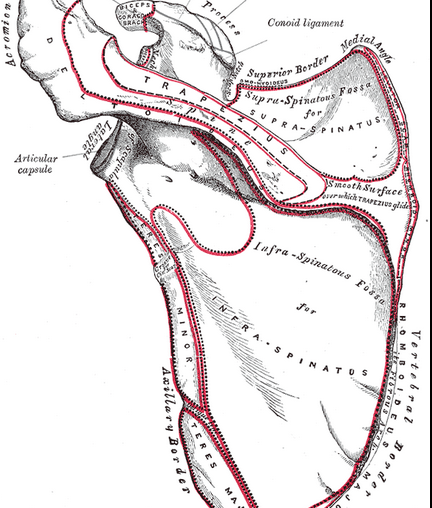I tend to have a “favorite” muscle. One at a time. That muscle, or muscle group that I’m fascinated with. Like I have a crush on it, it haunts my thoughts. I observe it in everyone I see, on the street, on my treatment table. Watching its behavior.
Right now, my muscle of the moment is the scalenes. Those muscles that run down the side of the neck, splitting in three, attaching to the first two ribs.
(Those first ribs are pretty high. Sometimes we tend to think of our ribs around our chest and sternum, but those first ribs are way up there).
And the scalenes attach to them. They attache to those first ribs.
Why is this so important?
Because when the scalenes tighten and shorten, they pull the head forward and rotate the shoulders internally. And this forms the classic “hunched over” posture that is so common in our modern world. A world that requires us, so often, to be at a desk; at a computer; driving in a car. All actions that tend to cause this hunched over shape, and the resulting tension in the muscles in the neck and back.
What’s interesting in treating people with shoulder and neck tension (read: everyone) is that sometimes, you can release the tense shoulder and neck muscles and it will feel really great. But it doesn’t necessarily lead to long term change.
In contrast, releasing the scalenes doesn’t feel so good. In fact, for the majority of people it’s downright uncomfortable. But to a person, when I release the scalenes, there is a noticeable and lasting difference in the neck and shoulder tension. When we release the long held tension that is pulling the head and neck forward and the shoulders in, all of those muscles on the back of the body can suddenly relax- sometimes, for the first time in years.
Massage Therapist Peggy Lamb, MA, LMT, describes the difference with this image: “Are you a bulldog or a great dane?”
The Bulldog’s head is pulled forward, between it’s shoulders, creating undue pressure on the rotator cuff muscles and eventually leading to chronic neck and shoulder tension and pain. The Great Dane, in contrast, has a long neck that is released and lengthened throughout the front muscles.
Now, as a dog lover, I happen to be a big fan of both bulldogs AND great danes. But for the purposes of this analogy… we want you, of course, to be a great dane.
But let’s go back for a moment to those interesting scalene muscles.
There is another nearly universal reaction whenever I treat the scalene muscles (besides general discomfort!)… and that reaction is surprise. “Why have I never felt them before? Why have I never felt that tension there?!”
One of the more fascinating aspects of practicing bodywork is observing which tension clients feel- and which areas of tension they do not feel. Ask a person on the street where they feel tension in their body, and chances are you’ll hear something about the neck, back, shoulders. These large muscles on the back body, as a general rule, tend to be where we are aware of tension in our bodies.
And yet those scalenes- those incredibly important muscles that are nearly always so very tight… have likely never been “felt” before. The client will say something to the effect of “I’ve never felt that and I can’t believe there’s so much tension!”
I believe there are many reasons for the phenomenon of why we feel the tension in some areas of our bodies, and are “out of touch” with others. One of the delicate balances of practicing bodywork is introducing clients to that “out of touch” tension… bringing them into contact with tension that they’ve never felt before… so that it can be released. The delicate balance comes into play because this is not necessarily a comfortable process. Reading the client’s entire system is essential, as is a deep and profound respect for the person’s well being on every level.
Another aspect of interest is the relationship between the scalenes and the breath. One of the primary actions of the scalene muscles is to elevate the first and second ribs to allow for breathing. When these muscles are chronically tight and constricted, the lungs will not expand to their optimal capacity, and restricted breathing results.
Considering the importance of the breath, those little scalene muscles become even more important!
A simple self myofascial stretch can bring a bit of easy release into the scalene area. Please proceed extremely gently with this exercise, and as always consult your health care provider if you have any questions or concerns.
Place your fingers just above the ridge formed by your collarbone. Using gentle pressure, begin to sink your fingers down into the soft tissue. Hold until you feel a release. Breathe, stretch, and repeat on the other side.
This stretch, while not necessarily going directly *into* the scalene muscles, will release the connective tissue that surrounds and moves through them. It’s an easy way to bring a bit of release to this area.

A qualified bodyworker or physical therapist can further release these incredibly important muscles.
Get to know your scalenes. Now that you’ve been introduced to them, start to notice them throughout your day. You may find that you can’t feel them, at first. Bringing sensory awareness to an area that has not been “felt” for some time is a process… but it’s one you can do, through awareness and practice. And once you “turn on” the feeling in these amazing muscles, you’ll have an awesome tool to help you with your ongoing wellness plan (not to mention, improved posture!)
Meet your scalenes… they’re glad to know you. I think you’ll like them, as well.






